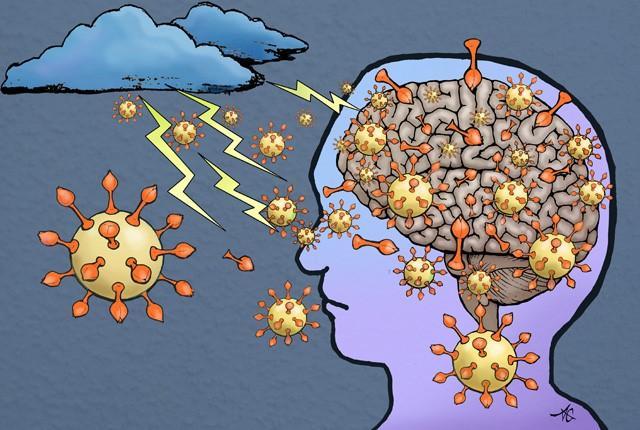The COVID-19 symptoms on the center stage are those associated with pneumonia and respiratory distress. But there are also a host of symptoms that relate to the central nervous system. Although it is unclear whether or not the SARS-CoV-2 virus can enter the brain, a new study found that the spike protein can cross the blood–brain barrier (BBB) in mice, strongly suggesting that it can.
The research is published in Nature Neuroscience in the paper, “The S1 protein of SARS-CoV-2 crosses the blood–brain barrier in mice.”
Coronaviruses, including the closely related SARS virus that caused the 2003–2004 outbreak, have been reported to be able to cross the BBB.
This new study assessed whether the spike protein of SARS-CoV-2, referred to as the S1 protein, can cross the BBB. With the host of symptoms that are related to the central nervous system, including loss of taste and smell, headaches, twitching, seizures, confusion, vision impairment, nerve pain, dizziness, impaired consciousness, nausea and vomiting, hemiplegia, ataxia, stroke, and cerebral hemorrhage, uncovering the link between the virus and the nervous system is of paramount importance.
The authors noted that the S1 protein can be used to “model the activity of the virus.” If the viral binding protein crosses the BBB, they say, “it is likely that protein enables the virus to cross the BBB as well.”
Binding proteins like S1 usually cause damage by themselves as they detach from the virus and cause inflammation, noted William A. Banks, MD, a professor of medicine at the University of Washington School of Medicine. “The S1 protein likely causes the brain to release cytokines and inflammatory products,” he said.
The Banks lab studies the blood–brain barrier in Alzheimer’s, obesity, diabetes, and HIV. But the lab members put their own research projects on hold in April, and started experimenting on the S1 protein.
Banks noted the S1 protein in SARS-CoV2 and the gp 120 protein in HIV-1 function similarly. They are glycoproteins—proteins that have a lot of sugars on them, hallmarks of proteins that bind to other receptors. Both of these proteins cross the blood–brain barrier and S1, like gp120, is likely toxic to brain tissues.
“It was like déjà vu,” said Banks, who has done extensive work on HIV-1, gp120, and the blood–brain barrier.
The team showed that intravenously injected radioiodinated S1 (I-S1) readily crossed the BBB in male mice and was taken up by brain regions and entered the parenchymal brain space. I-S1 was also taken up by the lung, spleen, kidney, and liver.
When I-S1 was administered intranasally, it also entered the brain, although at levels roughly ten times lower than after intravenous administration.
The sex of the mice did not affect whole-brain I-S1 uptake but “had variable effects on uptake by the olfactory bulb, liver, spleen, and kidney.” Transport of S1 was faster in the olfactory bulb and kidney of males than females. This observation might relate to the increased susceptibility of men to more severe COVID-19 outcomes.
“We know that when you have the COVID infection you have trouble breathing and that’s because there’s infection in your lung, but an additional explanation is that the virus enters the respiratory centers of the brain and causes problems there as well,” said Banks.
As for people taking the virus lightly, Banks has a message: “You do not want to mess with this virus,” he said. “Many of the effects that the COVID virus has could be accentuated or perpetuated or even caused by virus getting in the brain and those effects could last for a very long time.”



